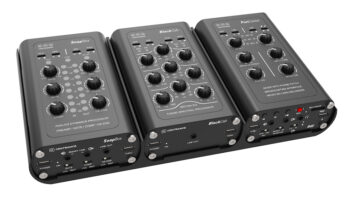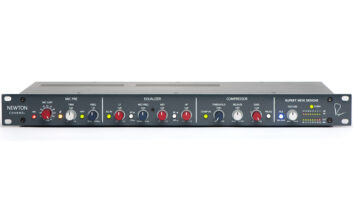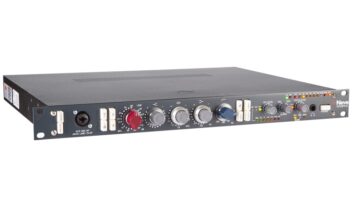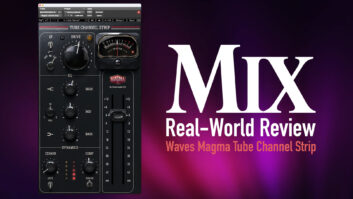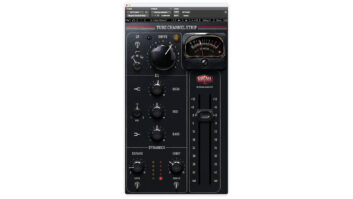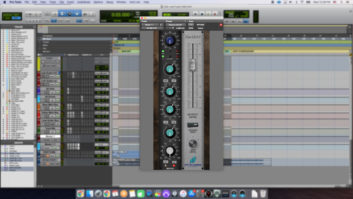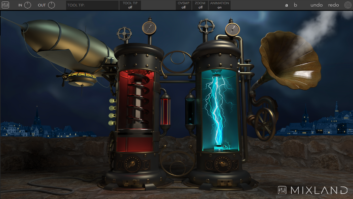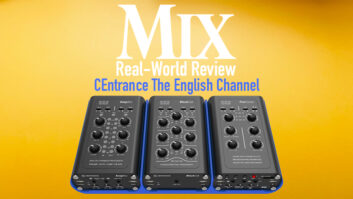The Channel Strip is the perfect studio addition for any API aficionado.
After being formed in 1968, API quickly rose to high esteem among the world’s top manufacturers in every musical genre to the point that many engineers prefer not to track through anything but an API desk. API pioneered modular design, and today its 500 series (VPR) format is a staple in recording studios of any caliber or size. API released the 1U The Channel Strip (TCS) — a comprehensive recording channel that includes a mic preamp, compressor and EQ — in November of 2010 and since then its popularity has continued to rise.

Features
The TCS combines three legendary API 500 series processors into a box with a built-in power supply. The TCS’ front panel mirrors the default signal flow and includes a 512c mic preamplifier, a 527 compressor, a 550A equalizer and an API 325 Line Driver output stage. Engineers who have used these modules in an API console or lunchbox will find the TCS variation to be almost identical with only minor differences such as the 512c’s lack of a dedicated input meter (although the output meter can be switched to show preamp output) and, unlike the modular 527, the compressor in the TCS lacks a dedicated output gain control. All of the switches on the TCS are backlit making their status easy to read.
The 512c mic preamplifier is selectable between Mic (rear-panel XLR), Line (rearpanel quarter-inch TRS) or Instrument (front-panel quarter-inch) and includes polarity reverse (reverses the polarity of all inputs), +48V phantom power, and a -20 dB pad. The 527 multi-mode Compressor includes variable Threshold, Attack, Release and Ratio, controlled via detented pots and a 10-segment meter that shows compression. Unfortunately, the meter works in reverse, meaning that all of the LED’s are illuminated when no compression is present and as the circuit compresses, LE Ds go dark signifying the gain reduction. I figured this would take a while to get used to but, after significant use, I never have. The default setting for the compressor is pre-EQ, but this can be changed with the Post-EQ button in the compressor section.
Next, the 550A three-band EQ includes switchable frequencies and 12 dB of boost or cut (+/- 2, 4, 6, 9 or 12 dB). The High and Low bands can be individually switched to be shelving EQs, and the “B.P. Filter” switch inserts a 50 Hz to 15 kHz bandpass filter. Borrowed from classic API console design, the TCS’s output stage is the 325 Line Driver which provides up to +30 dBm of clean gain before clipping. It includes a master mute switch, a meter switch (to select between mic pre output or channel strip output), a large rotary output fader and an insert switch.
The rear panel includes complete patching facilities and an IEC jack for power input. Power is switchable between 115/230 volts (50/60 Hz). Microphone input is via a female XLR connector, Channel output is via a male XLR connector and the remaining nine quarterinch TRS connectors provide Line In, First Effect In and Out, Second Effect in and Out, Insert Return, Compressor Side Chain In and DC Link (to link the compressors for stereo operation). Effect 1 and 2 are either Compressor or EQ but they can’t be labeled as such because their position is not fixed. The default is that the EQ utilizes the first effect jacks and the compressor utilizes the second effect jacks, but this reverses when the Post EQ button is activated. The multiple jacks allow the mic pre, compressor and equalizer to simultaneously be used as discrete devices.
All of the outputs are half-normaled to the subsequent stage so you can tap and split the output at any point in the path without disturbing signal flow to the next stage. The insert return jack facilitates incorporating an external device into the channel by patching “second effect out” to the external device and output of the external device to insert return. This path is inactive until the front panel Insert button is engaged. This is a great feature in that it allows you to have an additional processor added to the signal that can be activated or deactivated at the push of a button.
In Use
After engineering for well over 20 years, I have just recently come to the realization that nearly all of the albums I’ve tracked that I feel have truly standout drum sounds were tracked through an API console. The API preamps simply sound amazing, and their effect is cumulative, meaning that a full album tracked through an API desk sounds significantly better than one tracked through Brand X (read: nearly any other console made). Therefore, I was not surprised that during my review period, I used the TCS on a wide variety of sound sources, and I always had magnificent results.
During a tracking session, I used the TCS along with a Shure SM57 to record snare and it worked wonders. Pushing the preamp just past the point of saturation created a great edge to the snare drum smack. The box worked equally well capturing kick drum along with an AKG D112, and once again I had great results pushing the preamp just past the point of saturation.
The TCS’s instrument input is rich, full and punchy making it perfectly tailored for bass guitar. I found, in most instances, all that was required for the bass was a click or two of gain at 2.5 or 3 kHz and occasionally a slight boost at 50 Hz. The compressor also works wonderfully with bass guitar and the Thrust feature, which inserts a high-pass filter before the RMS detector, is indispensable, as it makes the bass tone literally pop out of a mix.
I used the TCS along with a Royer R-101 to record a clean, “chime-y” electric guitar through a Vox AC-30, and the result was wonderful. I used the same mic along with a Hughes & Kettner Puretone amp and a Randall RS212LB cabinet to capture a full-throttle distorted guitar sound and again had great results. In both instances, I found that with the Thrust feature engaged I was able to significantly compress a heavily distorted, beefy guitar tone without any pumping whatsoever.
I flew to Canada to record vocals on the latest Steven Curtis Chapman album, and I chose the TCS along with the ADK Vienna II microphone as the signal path, and it worked wonderfully. I needed something that would easily transport in my suitcase yet it needed to have enough sonic flexibility to adapt to any musical situation and the TCS delivered.
On another occasion, I used the box along with an AEA A440 ribbon mic to record male vocals, and the results were fantastic. The mic pre provides a clean, pristine sound quality until you begin to push it, and then the character of the pre really starts to show. This kind of flexibility is wonderful for someone who only owns one or two channels of mic pre.
Summary
API has created a modern-day classic with The Channel Strip and, with the inclusion of the API 325 Line Driver in the output stage, the module perfectly emulates the sound of an actual API console. Engineers familiar with the 512c, 527 and 550A component processors will literally fall in love with The Channel Strip.
Price: $2,995
Contact: API (Automated Processes, Inc.) | apiaudio.com
Russ Long is a Nashville-based producer, engineer and mixer as well as a senior contributor to PAR. russlong.ws
